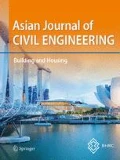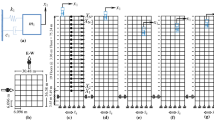Abstract
An economical solution to reduce building motions to an acceptable level, under dynamic loadings, is to provide additional damping. A passive damping device shown to be effective as a vibration control mechanism is tuned liquid damper (TLD). A TLD is a passive control system which utilizes fluid-sloshing motion to dissipate the lateral excitation energy. In this paper, the TLD was modeled as an equivalent nonlinear-tuned mass damper. Furthermore, the validity of the numerical procedure in predicting the structural response equipped with TLD under seismic loading is also investigated with two studies. To study the effectiveness of implementing TLDs, three existing intermediate steel moment-resisting frames were taken into consideration, and nonlinear response history analysis was carried out for structural models with and without TLDs. It was observed that TLDs can be utilized as seismic response mitigation devices and can also be employed for seismic rehabilitation of the existing steel structures. Even though the natural frequency of the TLD is always chosen to match the natural frequency of the structure, any change in the frequency of the primary structure or amplitude-dependent frequency of the TLD results in a detuned TLD system. Therefore, this paper also evaluates the efficiency of a detuned TLD system for some tuning ratios (0.8–1.2) by sensitivity analysis. The results showed that tuning ratio in the range of 0.9–1.1 has a slight influence on the seismic response of the structure.

















Similar content being viewed by others
References
Adam, C. (2001). Experimental investigation of small-scale shear frame models with tuned liquid column dampers. Asian Journal of Civil Engineering (BHRC), 2(1), 1–10.
AISC 360-10. (2010). Specification for structural steel buildings. Chicago: American Institute of Steel Construction.
ASCE/SEI 41-13. (2013). Seismic evaluation and retrofit of existing buildings. Virginia: American Society of Civil Engineers.
ASCE/SEI 7-10. (2010). Minimum design loads for buildings and other structures. Virginia: American Society of Civil Engineers.
Banerji, P., Murudi, M., Shah, A. H., & Popplewell, N. (2000). Tuned liquid dampers for controlling earthquake response of structures. Earthquake Engineering and Structural Dynamics, 29, 587–602.
Castaldo, P. (2014). Integrated seismic design of structure and control systems. Basel: Springer International Publishing.
Chopra, A. K. (2012). Dynamics of structures: theory and applications to earthquake engineering (4th ed.). Englewood Cliffs: Prentice Hall.
Constantinou, M. C., Soong, T. T., & Dargush, G. F. (1998). Passive energy dissipation systems for structural design and retrofit. Monograph No. 1. Buffalo: Multidisciplinary Center for Earthquake Engineering Research.
Das, S., Choudhury, S., & Dey, A. K. (2017). Performance of low-rise RC buildings with tuned liquid dampers (TLDS) in presence of masonry infill. Asian Journal of Civil Engineering (BHRC), 18(4), 535–546.
ETABS V.15.1.0. (2015). Integrated analysis, design and drafting of building systems. Computers and Structures Inc. (CSI): Berkeley.
Guneyisi, E. M., & Azez, I. (2016). Seismic upgrading of structures with different retrofitting methods. Earthquakes and Structures, 10(3), 589–611.
Hamelin, J. (2007). The Effect of Screen Geometry on the Performance of a Tuned Liquid Damper. M.Sc. thesis, McMaster University.
Ikeda, T., & Nakagawa, N. (1997). Non-linear vibrations of a structure caused by water sloshing in a rectangular tank. Journal of Sound and Vibration, 201, 23–41.
Kareem, A., Kijewski, T., & Tamura, Y. (1999). Mitigation of motions of tall buildings with specific examples of recent applications. Wind and Structures, 2(3), 201–251.
Kim, Y. M., You, K. P., Ko, N. H., & Yoon, S. W. (2006). Use of TLD and MTLD for control of wind induced vibration of tall buildings. Mechanical science and technology, 20(9), 1346–1354.
Lamb, H. (1932). Hydrodynamics. England: Cambridge University Press.
Matta, E. (2011). Performance of tuned mass dampers against near-field earthquakes. Structural Engineering and Mechanics, 39(5), 621–642.
Ni, P. (2014). Seismic assessment and retrofitting of existing structure based on nonlinear static analysis. Structural Engineering and Mechanics, 49(5), 631–644.
Reed, D., Yu, J. K., Yeh, H., & Gardarsson, S. (1998). Investigation of tuned liquid dampers under large amplitude excitation. Engineering Mechanics, 124, 405–413.
Shad, H., Adnan, A., Behbahani, H. P., & Vafaei, M. (2016). Efficiency of TLDs with bottom-mounted baffles in suppression of structural responses when subjected to harmonic excitations. Structural Engineering and Mechanics, 60(1), 131–148.
Sharma, A., Reddy, G. R., & Vaze, K. K. (2012). Shake table tests on a non-seismically detailed RC frame structure. Structural Engineering and Mechanics, 41(1), 1–24.
Soong, T. T., & Constantinou, M. C. (1994). Pssive and active structural vibration control in civil engineering. Wien: Springer-Verlag.
Soong, T. T., & Dargush, G. F. (1997). Passive energy dissipation systems in structural engineering. England: Wiely.
Sun, L. M., Fujino, Y., Chaiseri, P., & Pacheco, B. M. (1995). The properties of tuned liquid dampers using a TMD analogy. Earthquake Engineering and Structural Dynamics, 24, 967–976.
Sun, L. M., Fujino, Y., Pacheco, B. M., & Chaiseri, P. (1992). Modelling of tuned liquid damper (TLD). Journal of Wind Engineering and lndustrial Aerodynamics, 41–44, 1883–1894.
Sun, L. M., Fujino, Y., Pacheco, B. M., & Isobe, M. (1989). Nonlinear waves and dynamic pressure in rectangular tuned liquid damper (TLD): Simulation and experimental verification. Structural Engineering/Earthquake Engineering (JSCE), 6(2), 251–262.
Tait, M. J. (2008). Modelling and preliminary design of a structure-TLD system. Engineering Structures, 30, 2644–2655.
Takewaki, I. (2009). Building control with passive dampers: optimal performance-based design for earthquakes. Singapore: Wiley.
Tamura, Y., Fujii, K., Ohtsuki, T., Wakahara, T., & Kohsaka, R. (1995). Effectiveness of Tuned liquid dampers under wind excitation. Engineering Structures, 17(9), 609–621.
Tamura, Y., Kohsaka, R., Nakamura, O., Miyashita, K. I., & Modi, V. J. (1996). Wind-induced responses of an airport tower-efficiency of tuned liquid damper. Wind Engineering and Industrial Aerodynamics, 65, 121–131.
Vancliver, J. K., & Mitome, S. (1979). Effect of liquid storage tanks on the dynamic response of offshore platform. Applied Ocean Research, 1, 67–74.
Wakahara, T., Ohyama, T., & Fujii, K. (1992). Suppression of wind-induced vibration of a tall building using tuned liquid. Wind Engineering and Industrial Aerodynamics, 43, 1895–1906.
Wang, J. T., Gui, Y., Zhu, F., Jin, F., & Zhou, M. X. (2016). Real-time hybrid simulation of multistory structures installed with tuned liquid damper. Structural Control and Health Monitoring, 23(7), 1015–1031.
Warburton, G. B. (1981). Optimum absorber parameters for minimizing vibration response. Earthquake Engineering and Structural Dynamics, 9, 251–262.
Yi, F., & Dyke, S. J. (2000). Structural control systems: Performance assessment. Proceedings of the American Control Conference, Chicago, Illinois, USA, June, 1, 14–18.
Yu, J. K. (1997). Nonlinear characteristics of tuned liquid dampers. Ph.D. Dissertation, University of Washington.
Yu, J. K., Wakahara, T., & Reed, D. A. (1999). A non-linear numerical model of the tuned liquid damper. Earthquake Engineering and Structural Dynamics, 28(6), 671–686.
Author information
Authors and Affiliations
Corresponding author
Ethics declarations
Conflict of interest
On behalf of all authors, the corresponding author states that there is no conflict of interest.
Rights and permissions
About this article
Cite this article
Akbarpoor, S., Dehghan, S.M. & Hadianfard, M.A. Seismic performance evaluation of steel frame structures equipped with tuned liquid dampers. Asian J Civ Eng 19, 1037–1053 (2018). https://doi.org/10.1007/s42107-018-0082-8
Received:
Accepted:
Published:
Issue Date:
DOI: https://doi.org/10.1007/s42107-018-0082-8




